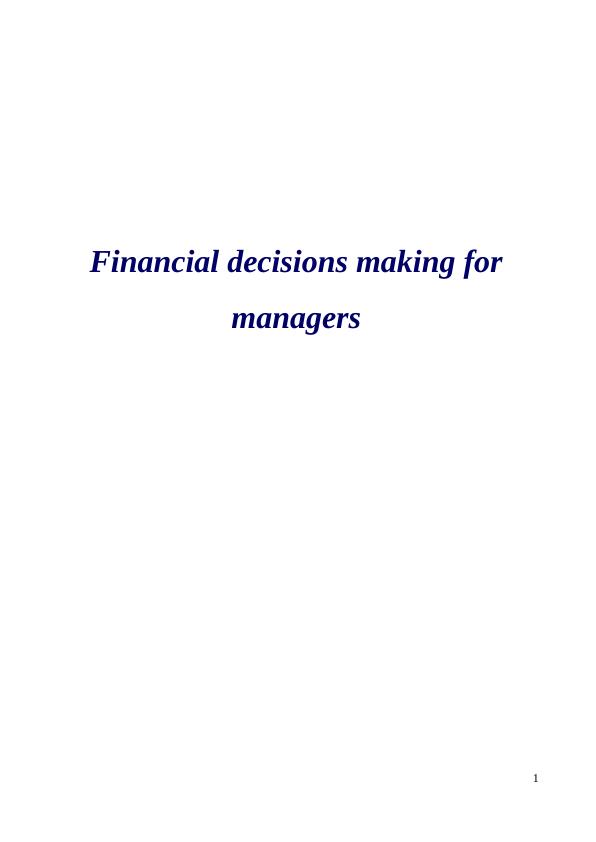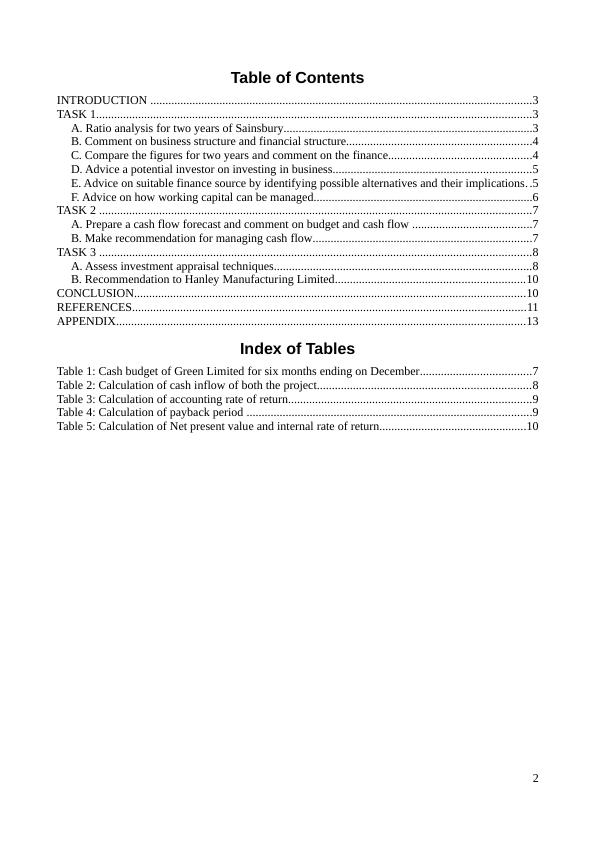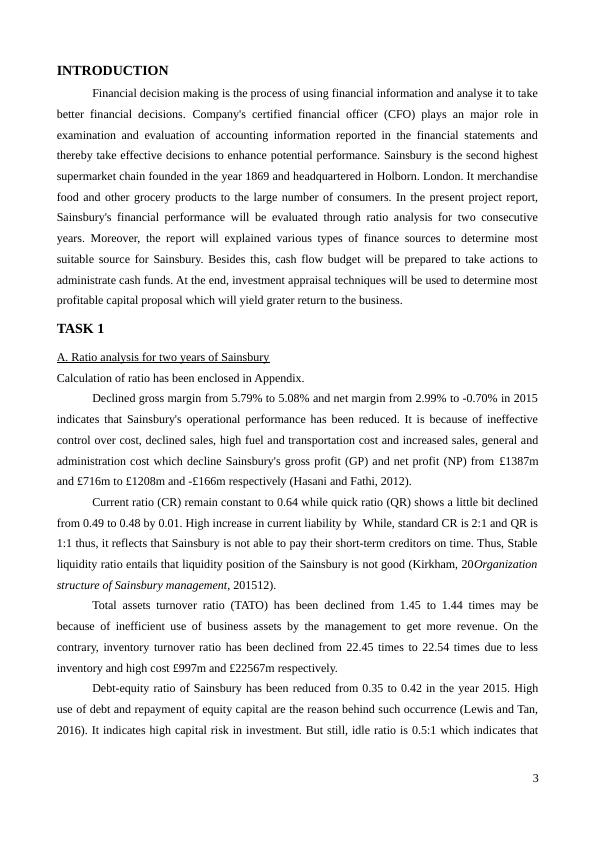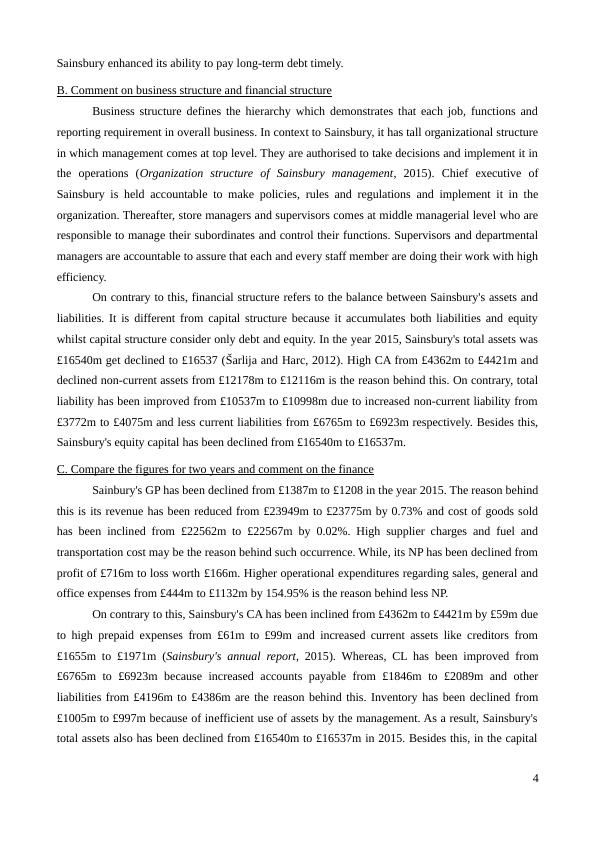Financial decisions making for managers: Assignment
Added on 2019-12-17
14 Pages4616 Words85 Views
Financial decisions making formanagers1

Table of ContentsINTRODUCTION ...............................................................................................................................3TASK 1.................................................................................................................................................3A. Ratio analysis for two years of Sainsbury...................................................................................3B. Comment on business structure and financial structure..............................................................4C. Compare the figures for two years and comment on the finance................................................4D. Advice a potential investor on investing in business..................................................................5E. Advice on suitable finance source by identifying possible alternatives and their implications..5F. Advice on how working capital can be managed.........................................................................6TASK 2 ................................................................................................................................................7A. Prepare a cash flow forecast and comment on budget and cash flow ........................................7B. Make recommendation for managing cash flow.........................................................................7TASK 3 ................................................................................................................................................8A. Assess investment appraisal techniques......................................................................................8B. Recommendation to Hanley Manufacturing Limited...............................................................10CONCLUSION..................................................................................................................................10REFERENCES...................................................................................................................................11APPENDIX........................................................................................................................................13Index of TablesTable 1: Cash budget of Green Limited for six months ending on December.....................................7Table 2: Calculation of cash inflow of both the project.......................................................................8Table 3: Calculation of accounting rate of return.................................................................................9Table 4: Calculation of payback period ...............................................................................................9Table 5: Calculation of Net present value and internal rate of return.................................................102

INTRODUCTION Financial decision making is the process of using financial information and analyse it to takebetter financial decisions.Company's certified financial officer (CFO) plays an major role inexamination and evaluation of accounting information reported in the financial statements andthereby take effective decisions to enhance potential performance. Sainsbury is the second highestsupermarket chain founded in the year 1869 and headquartered in Holborn. London. It merchandisefood and other grocery products to the large number of consumers. In the present project report,Sainsbury's financial performance will be evaluated through ratio analysis for two consecutiveyears. Moreover, the report will explained various types of finance sources to determine mostsuitable source for Sainsbury. Besides this, cash flow budget will be prepared to take actions toadministrate cash funds. At the end, investment appraisal techniques will be used to determine mostprofitable capital proposal which will yield grater return to the business. TASK 1A. Ratio analysis for two years of SainsburyCalculation of ratio has been enclosed in Appendix. Declined gross margin from 5.79% to 5.08% and net margin from 2.99% to -0.70% in 2015indicates that Sainsbury's operational performance has been reduced. It is because of ineffectivecontrol over cost, declined sales, high fuel and transportation cost and increased sales, general andadministration cost which decline Sainsbury's gross profit (GP) and net profit (NP) from £1387mand £716m to £1208m and -£166m respectively (Hasani and Fathi, 2012). Current ratio (CR) remain constant to 0.64 while quick ratio (QR) shows a little bit declinedfrom 0.49 to 0.48 by 0.01. High increase in current liability by While, standard CR is 2:1 and QR is1:1 thus, it reflects that Sainsbury is not able to pay their short-term creditors on time. Thus, Stableliquidity ratio entails that liquidity position of the Sainsbury is not good (Kirkham, 20Organizationstructure of Sainsbury management, 201512). Total assets turnover ratio (TATO) has been declined from 1.45 to 1.44 times may bebecause of inefficient use of business assets by the management to get more revenue. On thecontrary, inventory turnover ratio has been declined from 22.45 times to 22.54 times due to lessinventory and high cost £997m and £22567m respectively. Debt-equity ratio of Sainsbury has been reduced from 0.35 to 0.42 in the year 2015. Highuse of debt and repayment of equity capital are the reason behind such occurrence (Lewis and Tan,2016). It indicates high capital risk in investment. But still, idle ratio is 0.5:1 which indicates that3

Sainsbury enhanced its ability to pay long-term debt timely. B. Comment on business structure and financial structureBusiness structure defines the hierarchy which demonstrates that each job, functions andreporting requirement in overall business. In context to Sainsbury, it has tall organizational structurein which management comes at top level. They are authorised to take decisions and implement it inthe operations (Organization structure of Sainsbury management, 2015). Chief executive ofSainsbury is held accountable to make policies, rules and regulations and implement it in theorganization. Thereafter, store managers and supervisors comes at middle managerial level who areresponsible to manage their subordinates and control their functions. Supervisors and departmentalmanagers are accountable to assure that each and every staff member are doing their work with highefficiency. On contrary to this, financial structure refers to the balance between Sainsbury's assets andliabilities. It is different from capital structure because it accumulates both liabilities and equitywhilst capital structure consider only debt and equity. In the year 2015, Sainsbury's total assets was£16540m get declined to £16537 (Šarlija and Harc, 2012). High CA from £4362m to £4421m anddeclined non-current assets from £12178m to £12116m is the reason behind this. On contrary, totalliability has been improved from £10537m to £10998m due to increased non-current liability from£3772m to £4075m and less current liabilities from £6765m to £6923m respectively. Besides this,Sainsbury's equity capital has been declined from £16540m to £16537m. C. Compare the figures for two years and comment on the financeSainbury's GP has been declined from £1387m to £1208 in the year 2015. The reason behindthis is its revenue has been reduced from £23949m to £23775m by 0.73% and cost of goods soldhas been inclined from £22562m to £22567m by 0.02%. High supplier charges and fuel andtransportation cost may be the reason behind such occurrence. While, its NP has been declined fromprofit of £716m to loss worth£166m. Higher operational expenditures regarding sales, general andoffice expenses from £444m to £1132m by 154.95% is the reason behind less NP. On contrary to this, Sainsbury's CA has been inclined from £4362m to £4421m by £59m dueto high prepaid expenses from £61m to £99m and increased current assets like creditors from£1655m to £1971m (Sainsbury's annual report, 2015). Whereas, CL has been improved from£6765m to £6923m because increased accounts payable from £1846m to £2089m and otherliabilities from £4196m to £4386m are the reason behind this. Inventory has been declined from£1005m to £997m because of inefficient use of assets by the management. As a result, Sainsbury'stotal assets also has been declined from £16540m to £16537m in 2015. Besides this, in the capital4

End of preview
Want to access all the pages? Upload your documents or become a member.
Related Documents
Comparative ratio analysis of Morrison for the year 2014 and 2015lg...
|16
|5019
|262
Financial Performance Analysislg...
|16
|4254
|64
Report On Asol Ltd & Next Plc Performance For Investment Decisionlg...
|16
|3811
|33
Ratio Analysis and Investment Appraisal of Greggs plc. and Tekna Electronicslg...
|11
|2584
|323
Report On Financial Analysis Of M&S And Sainsbury Plclg...
|15
|4231
|128
Analysis of Financing - Sainsbury and Tescolg...
|20
|4362
|182
